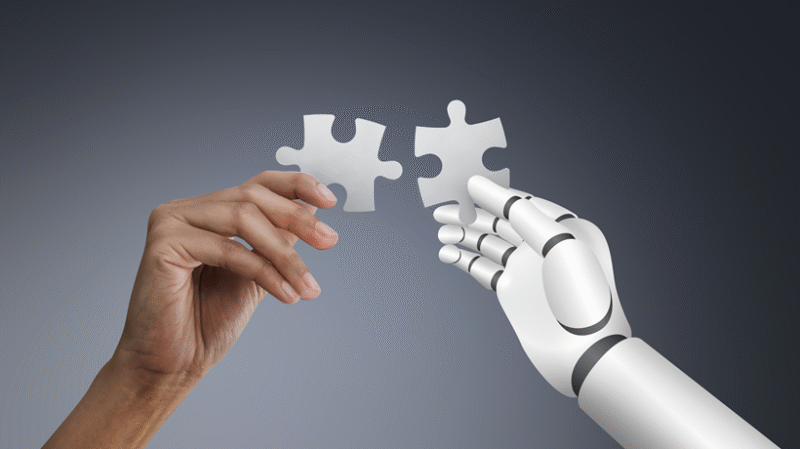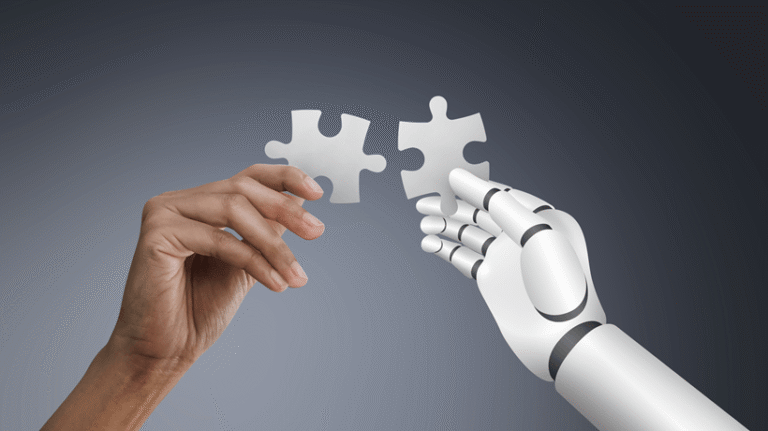
Summary: The state of AI in our organizations
Earlier we looked at three types of organizations with different levels of AI adoption. Scenario 1 described an early adopter where AI lives, thrives, and is actively managed by humans.
What do they have that others don’t? Strategic AI Foundation.
As with anything worth building, implementing AI requires a solid foundation. It is strong enough to protect the population, yet flexible enough to be built and strengthened over time.
Without this, AI implementation will not only be ad hoc; It’s incredibly dangerous. Scenarios 2 and 3 involve a large amount of unvetted AI tools and unreviewed and untested output of varying quality and accuracy.
AI for L&D: SweetRush’s human-centered strategy framework
Previously, we shared a brief overview of this pyramid. The pyramid was designed to help L&D leaders systematically map their AI ecosystem, expand human potential, and foster ethical and nuanced AI efforts across their organizations.
This article focuses on the base of the pyramid, the strategic foundation. The Strategic Foundation forms a critical AI foundation, including a secure data strategy and AI principles, a custom knowledge base for in-house knowledge and expertise, and AI-VR pairings between functions.
This article focuses on three key components (and benefits) of a strategic foundation.
Responsible AI Strategy and Roadmap Enterprise AI and Digital Twin Solutions Human-Centered Knowledge Design for AI
Responsible AI strategy and roadmap
Building accountability into your AI strategy from the ground up is more than just compliance; it’s strategically essential to long-term success.
We also need to consider the impact of AI on humans. AI is part of a rapidly evolving skill set that will dramatically change the roles and opportunities of workers in the near future.
“On average, workers can expect two-fifths (39%) of their existing skill sets to be transformed or rendered obsolete between 2025 and 2030.”
“If the global workforce is 100 people, by 2030 59 people will need training.
Of these, the employer estimates that 29 people could be upskilled in their current roles and 19 could be upskilled and redeployed elsewhere within the organization.
However, it is unlikely that the 11 will receive the necessary reskilling or upskilling.
Their employment prospects will become increasingly at risk. ”
—World Economic Forum “The Future of Jobs” Report 2025
Organizations urgently need to develop ethical strategies and roadmaps to manage the impact of AI on humans. This includes creating guardrails for responsible use and human oversight. These guidelines and guardrails will accelerate AI adoption. Team members who understand AI and how to use it are more likely to use it and less likely to fear or mistrust it.
The basic roadmap process looks like this:
The beginning: AI principles
To build a responsible AI strategy, it’s important to focus on values-based AI principles and the necessary mental model shift (MMS).
How do we land on these? We leverage information from internal communication channels, values, existing AI guidelines, and more. We also conduct qualitative analysis and empathetic interviews with employees.
Then use your findings about what’s important to your organization to co-create your own AI principles, such as “transparency” and “cost sensitivity.”
Changing AI mental models
Of course, just telling people about new tools and policies isn’t enough. To bring about real change and drive new behaviors, we need to understand and address underlying attitudes such as “I’m anxious about AI” and “I can’t use AI tools in my role.”
There is a change. Next, define the key mindset and behavioral changes required for employees to embrace AI and contribute to a cohesive AI culture within your organization. By aligning MMS with your own AI principles, we empower your team to enact and bring those principles to life.
(Would you like to see some case studies on real-world AI principles and changing mental models? These can be found in Chapter 1 of our e-book, The AI Blueprint: Actionable Strategies For L&D Leaders To Reduce Value, Add Value of AI At Scale.)
AI meets humanity: Securing human workflows
The Turing test is another step we use when building a responsible AI strategy. Proposed by Alan Turing in 1950, these tests aimed to answer the question, “Can machines think?”
Machines were said to exhibit human-level intelligence, even if a human judge could not tell whether the person speaking was a human or a machine.
At SweetRush, we conduct internal Turing tests to assess how and when AI amplifies human potential, and when it does not or should not amplify it.
Here’s how it works: By comparing the output of AI, such as language or storytelling, with the output of human experts, human judges identify its origins (human or AI), where AI excels, where development is needed, and where human insight is important.
This process helps clarify which tasks to automate and identifies new opportunities to enhance human expertise.
AI Integrity: What we say we practice.
Quality and accuracy of results are the top concerns our client partners express about AI, and we feel the same way.
As L&D professionals, misinformation and bias are anathema to us and can cause lasting damage to your organization.
That’s why we have committed to an ethical coordination strategy that prioritizes accuracy, transparency and human verification in all processes, without exception.
We practice what we preach by fact-checking all AI output and employing AI detection, using purpose-built tools to maintain accuracy and support human oversight.
In doing so, we ensure that all AI initiatives are inherently built on trust and ethical principles, and that these are a priori of a solid strategic foundation.
Human-centered knowledge design for AI
As designers of innovative learning programs, we’re always thinking about ways to combine human insight with AI. One way to bring the two together is to create a custom knowledge base, a meaningful, multifunctional repository of your organization’s knowledge and wisdom. These are part of the foundation of the entire AI ecosystem.
Cultivating organizational wisdom in the age of AI
With over 400 million terabytes of data generated every day, it’s difficult to filter what’s relevant, what’s accurate, and how it all fits together. That applies to us and our learners as well.
However, you can add value by organizing and indexing the following types of information:
Data is raw facts. Once data is organized, it rises to the status of information. Organizational knowledge is an organization’s documented facts and processes, all of which are important for effectiveness. But organizational wisdom goes deeper and involves the insightful application of organizational knowledge, including ethics, long-term thinking, and nuanced judgment. It is a source of people’s creativity and curiosity, and helps encourage behavioral change.
SweetRush’s human-centered knowledge design process
Our knowledge design process outlines a holistic, human-centered approach to transforming the wisdom in the minds of your internal experts into powerful, versatile content. Retrieving this content can power your AI applications, enrich your website, and enhance your learning programs.
Each stage of the process includes:
Identify and map expertise, uncover who holds key knowledge and insights, and where your collective talent actually lies. We collect and document direct wisdom from experts and learners, focusing on the tacit knowledge, valuable stories, and nuanced advice that form an organization’s “truth.” Finally, use a robust framework to structure and index this knowledge, making it reusable and accessible.
This body of knowledge powers two important pathways:
Powerful AI applications: For example, AI coaches that provide contextual feedback and just-in-time knowledge bring high-touch, one-on-one coaching experiences to a wider audience, extending the reach of human experts. Non-AI applications that include insights for strategic planning, operational optimization, and enhancing HR initiatives using knowledge “downloaded” from the most experienced and successful in-house experts.
(For more examples of organizational wisdom in action, check out our e-book, The AI Blueprint: Actionable Strategies for L&D Leaders to Reduce Risk, Add Value, and Unlock the Benefits of AI at Scale.)
Enterprise AI and Digital Twin Solutions
Digital twins are dynamic virtual replicas of places, objects, and even people. These are often built using immersive technologies such as augmented reality (AR), virtual reality (VR), and mixed reality (MR).
Headsets are a great way to visit, but are not required. Digital twins can be built using WebXR, a web-based immersive technology that can be accessed through a standard browser window on any device.
AI-powered digital twins provide deep business insights and help maximize the value of 3D digital assets across your organization, from internal functions like L&D to external functions like recruiting and customer engagement.
Virtual worlds, real impact: Enterprise AI and digital twins
Digital twins, whether representing people, places, or things, bring new insights and efficiencies across a wide range of industries and sectors.
The benefits of digital twins are:
Deeper understanding with spatial insights and dynamic feedback Increase efficiency Enhance collaboration Transformational experiences in learning, marketing, and strategy
The true power of digital twins lies in their multifunctional value. Here are just a few of the ways you can leverage different areas of your organization to bring life to your learners, customers, key stakeholders, and more.
Digital twins can be accessed through a variety of devices, from exhibition “caves” to laptops and tablets, headsets, and even 3D models embedded in videos.
(See three real-world case studies on digital twins of people, places, and objects in our e-book, The AI Blueprint: L&D Leaders To Reduce Value, and Unlock the Benefits of AI at Scale.)
Are you ready for the next level of AI?
We hope you feel inspired to break ground or expand on your strategic foundation. In the next article, we’ll introduce you to the middle levels of the pyramid and explain how to put your basic AI strategy and roadmap into action.
If you want to be your own tour guide, download our e-book, The AI Blueprint: Actionable Strategies for L&D Leaders To Reduce, Value Add, and Unlock the Benefits of AI at Scale. From secure foundations to peak implementation, you’ll find a comprehensive plan to help you build your AI strategy.


